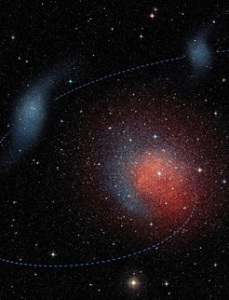Feb 26 2014
Galaxies grow by attracting and ingesting smaller galaxies, or by merging with other galaxies of comparable size. Now, a team of astronomers, including Glenn van de Ven from the Max Planck Institute of Astronomy, have identified the smallest example of a remnant of such a galactic merger: the dwarf spheroidal galaxy Andromeda II (AndII), a satellite of the well-known Andromeda galaxy.
From the motion of stars within this galaxy, the researchers identified two distinct groups of stars – what appears to be stars of the original dwarf galaxy, and stars from another dwarf galaxy that merged with AndII more than 3 billion years ago.
 Colliding worlds: Artist's impression of the merger between two smaller dwarf galaxies; the result was the dwarf galaxy Andromeda II. © N. C. Amorisco & M. Høst (Niels Bohr Institute) and ESO / Digitized Sky Survey 2
Colliding worlds: Artist's impression of the merger between two smaller dwarf galaxies; the result was the dwarf galaxy Andromeda II. © N. C. Amorisco & M. Høst (Niels Bohr Institute) and ESO / Digitized Sky Survey 2
The discovery started out as an anomaly: A group of astronomers in the USA, led by Marla Geha, had measured velocities of more than 700 stars in AndII, and found that the overall rotation was not only much faster than in other dwarf spheroidal galaxies but also rather unusual in orientation: Usually, galaxies spin like a wheel along its axis. In comparison, this galaxy tumbled head over heel.
With this anomaly in mind, the astronomers kindly provided their data to a group of researchers well-known for their experience in modelling stellar motion in galaxies: Nicola Amorisco of the University of Copenhagen, Wyn Evans of Cambridge University, and Glenn van de Ven of the Max Planck Institute for Astronomy.
Amorisco, Evans and van de Ven carefully re-analysed the velocities of the stars within AndII, and found an explanation for the anomaly: AndII seems to be the remnant of a merger of two even smaller dwarf galaxies. The unusual rotation is then a consequence of the smaller dwarf galaxy orbiting the larger one before being absorbed.
As van de Ven explains: “Through a detailed analysis of the motions of more than 700 individual stars, we could show that there are two distinct groups of stars: Those of the original dwarf galaxy, and those in a stellar stream wrapped around the inner regions of AndII like a belt.”
Interestingly, already in 2007 in a study of the distribution of stars in AndII, astronomers had speculated about a possible relic of an earlier merger: an unusual group of very old stars within the galaxy. The discovery of the stellar stream puts this speculation onto much firmer ground.
Such stellar streams, the characteristic remnant of a smaller galaxy captured by a larger one, have been found around our own Milky Way galaxy and other larger galaxies – but never for a galaxy with a mass of less than a billion Suns. And II has a much lower mass, corresponding to a mere 10 million Suns. Amorisco says: “Up until now, astronomers have only found traces of later stages of galaxy evolution – where at least one of the galaxies was already fairly massive, the result of many previous mergers and captures. This is the first example for a stellar stream in a very small galaxy.” Van de Ven adds: “Current galaxy formation models assume that this is how galactic growth began – with small dwarf galaxies swallowing even smaller dwarfs. But before this, nobody had found an example at such low mass scales.”
Amorisco, Evans and van de Ven hope that the next discoveries of this kind might be just around the corner. Van de Ven says: “We know there are astronomers out there who have similar data for other dwarf galaxies. With our method of analysis, they should be able to look for traces of stellar streams in other dwarf galaxies – and maybe identify even less massive examples.” Even with this one example, it looks like the current model of galaxy evolution is right on the money when it comes to explaining where little galaxies come from.